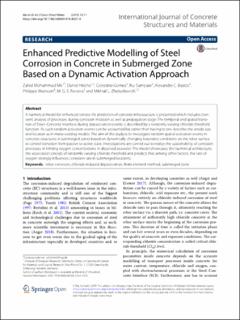Enhanced Predictive Modelling of Steel Corrosion in Concrete in Submerged Zone Based on a Dynamic Activation Approach
Mir, Zahid Mohammad; Hoche, Daniel; Gomes, Celestino; Sampaio, Rui; Bastos, Alexandre C; Maincon, Philippe Emmanuel; Ferreira, M.G.S.; Zheludkevich, Mikhail L
Journal article, Peer reviewed
Published version
Permanent lenke
https://hdl.handle.net/11250/2653598Utgivelsesdato
2019Metadata
Vis full innførselSamlinger
- Publikasjoner fra CRIStin - SINTEF AS [5802]
- SINTEF Industri [1566]
Originalversjon
International Journal of Concrete Structures and Materials. 2019, 13 (11), 1-18. 10.1186/s40069-018-0321-0Sammendrag
A numerical model for enhanced service life prediction of concrete infrastructure is presented which includes transient analysis of processes during corrosion initiation as well as propagation stage. The temporal and spatial transition of Steel–Concrete Interface during depassivation events is described by a randomly varying chloride threshold function. As such random activation events can be accounted for, rather than having to pre-describe the anode size and location as in many existing models. The aim of the study is to investigate random spatial activation events in concrete structures in submerged zones based on dynamically changing boundary conditions on the rebar surface to control transition from passive to active state. Investigations are carried out to realize the sustainability of corrosion processes in limiting oxygen concentrations in dissolved seawater. The model showcases the numerical architecture, the associated concept of randomly varying chloride threshold and predicts that among other factors, the rate of oxygen strongly influences corrosion rate in submerged locations.

